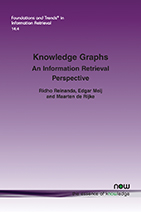Knowledge Graphs: An Information Retrieval Perspective
By Ridho Reinanda, Bloomberg, UK, rreinanda@bloomberg.net | Edgar Meij, Bloomberg, UK, emeij@bloomberg.net | Maarten de Rijke, University of Amsterdam & Ahold Delhaize, The Netherlands, m.derijke@uva.nl
Abstract
In this survey, we provide an overview of the literature on knowledge graphs (KGs) in the context of information retrieval (IR). Modern IR systems can benefit from information available in KGs in multiple ways, independent of whether the KGs are publicly available or proprietary ones. We provide an overview of the components required when building IR systems that leverage KGs and use a task-oriented organization of the material that we discuss. As an understanding of the intersection of IR and KGs is beneficial to many researchers and practitioners, we consider prior work from two complementary angles: leveraging KGs for information retrieval and enriching KGs using IR techniques. We start by discussing how KGs can be employed to support IR tasks, including document and entity retrieval. We then proceed by describing how IR—and language technology in general—can be utilized for the construction and completion of KGs. This includes tasks such as entity recognition, typing, and relation extraction. We discuss common issues that appear across the tasks that we consider and identify future directions for addressing them. We also provide pointers to datasets and other resources that should be useful for both newcomers and experienced researchers in the area.
Knowledge Graphs: An Information Retrieval Perspective
The aim of this survey is to bridge two important components of modern information access: information retrieval (IR) and knowledge graphs (KGs). Modern IR systems can benefit from information available in KGs in multiple ways, independent of whether the KGs are publicly available or proprietary ones. The authors provide an overview of the literature on KGs in the context of IR and the components required when building IR systems that leverage KGs. As an understanding of the intersection of IR and KGs is beneficial to many researchers and practitioners, they consider prior work from two complementary angles: leveraging KGs for information retrieval and enriching KGs using IR techniques. They summarize research work, group related approaches, and discuss challenges shared across tasks at the interface of IR and KGs.
In Knowledge Graphs: An Information Retrieval Perspective, the authors present an extensive overview of tasks related to KGs from an IR perspective, provide a thorough review for each task, and present discussions on common issues that are shared among the tasks. They discuss common issues that appear across the tasks that consider and identify future directions for addressing them. They also provide pointers to datasets and other resources that should be useful for both newcomers and experienced researchers in the area.
